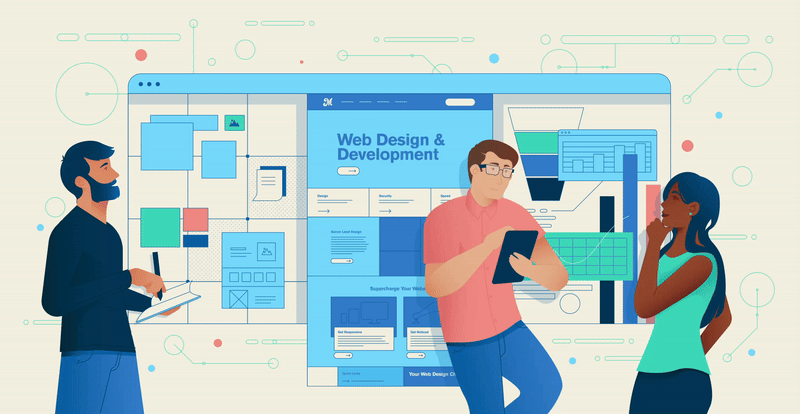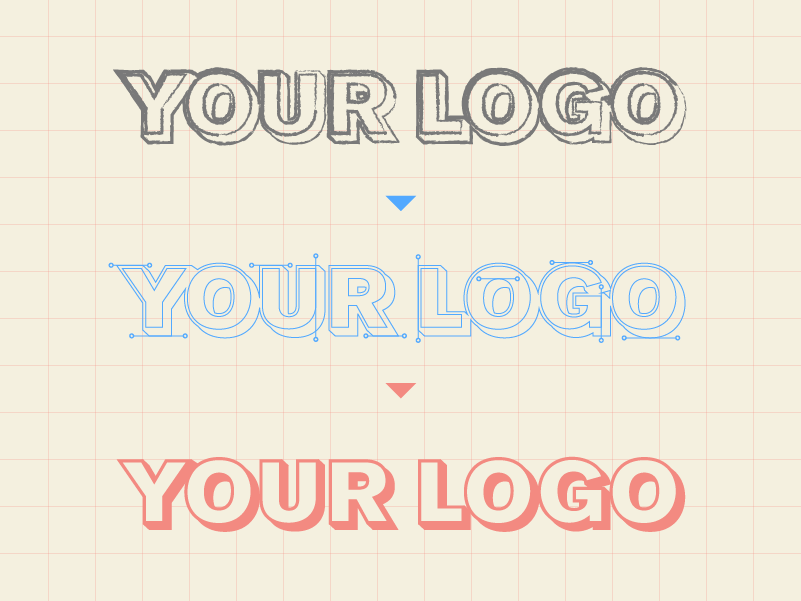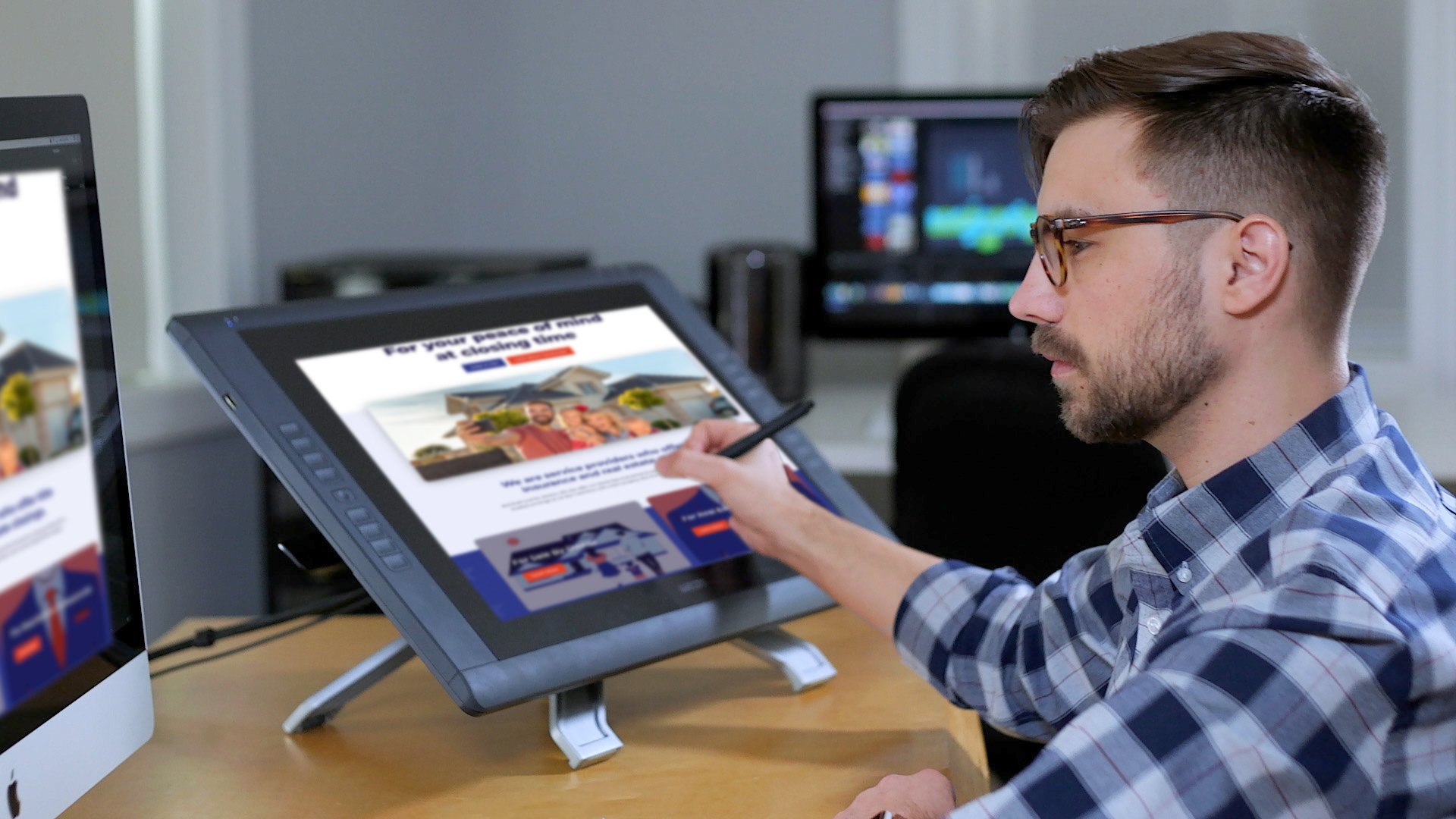The branding process is much more than just cranking out a logo and pasting it on everything; it’s about creating a cohesive brand identity.
This article was updated on 03/05/2025
That’s why, for many, there’s a lot of confusion about your brand and its meaning. And there’s even more confusion about where to begin your branding journey. Here’s a quick preview of our branding journey:
- Your brand is your reputation — and branding is the process of shaping how people perceive your business through strategy, visuals, and messaging.
- Poor branding creates confusion — without a cohesive approach, your business can come off as inconsistent or untrustworthy.
- Start strong with research — understanding your audience, competitors, and market ensures your brand is built on real insight, not guesswork.
- Consistency is everything — from your logo and color palette to your voice and website, every touchpoint should tell the same brand story.
- Invest in pros and high-quality assets — great design, messaging, and media elevate your brand and give you an edge across every platform.
Let’s kick things off with a quick branding refresher: your brand is your reputation, the way people perceive your business. While you can’t control every thought they have, you can control the actions and decisions that shape those perceptions. That’s the power of branding.
That process of swaying those perceptions a certain way is called branding (which includes your brand strategy). And since those perceptions will make or break whether they decide to buy into your business, they’re pretty important!
This is why it’s all the more important to start the brand building process for your business the right way.
Unfortunately, many businesses begin with an ineffective approach to their branding. Poor strategy may result from a limited budget, time constraints, or consulting with someone who has little to no experience with branding strategy. Unsurprisingly, a disjointed approach results in a confused perception of your brand, which leads to people not taking you seriously.
Think of it this way: showing up to a first date in a suit jacket, swim trunks, and steel-toe boots might make an impression but probably not the one you want. Each item has its place, just not together.
Branding works the same way. A thoughtful brand strategy is like a well-curated wardrobe: everything fits, everything complements, and no matter the occasion, your business shows up polished and ready to impress.
Brand building is essential for creating and establishing a strong brand identity and presence. It involves continuous engagement and evolving the brand to maintain relevance within the market.
Fortunately, we have six steps to ensure that you’re starting the branding process the right way!
Table of Contents

What is a Brand?
A brand is much more than just a name or a logo; it’s the unique identity that sets your business apart from the competition. It encompasses the values, brand’s personality, and message that you want to convey to your target audience. Think of your brand as the reputation of your business—how people perceive you and what they think of when they hear your name.
What is Brand Identity?
Brand identity, on the other hand, is the visual and verbal representation of your brand. This includes your name, logo, colors, typography, and tone of voice. A strong brand identity is essential for building a successful brand because it helps establish your company’s reputation, build trust with customers, and differentiate you from competitors. When your brand identity is clear and consistent, it creates a memorable impression that resonates with your audience and fosters loyalty.

Defining Your Target Audience
Understanding your target audiences is a critical step in building a successful brand. This involves gathering data and insights about your ideal customers, including their demographics, interests, behaviors, and pain points. By doing so, you can create detailed buyer personas, fictional representations of your ideal customers that help you tailor your brand strategy to meet their needs.
Researching your target market allows you to develop a brand voice, brand positioning, and visual identity that resonate with your audience. It helps you understand who your ideal customers are, what they care about, and how they interact with brands similar to yours. This knowledge is invaluable in creating a brand that stands out and connects with your audience on a deeper level.
Some key questions to ask when researching your target market include:
- Who are my ideal customers?
- What are their demographics, interests, and behaviors?
- What are their pain points and challenges?
- How do they currently interact with my brand or similar brands?
- What are their goals and aspirations?

Step 1: Hiring the Right Branding Team
The most important step to branding your business is to ensure you’re hiring the right talent for the job. This can either be a freelance designer, a branding agency or even your own internal team of creatives. Regardless of who you choose to work with, it’s imperative that they are experienced, professional, and reputable. Hiring a team with an experienced Creative Director should be at the top of the list. Sometimes it takes a village.
Hiring professionals well-versed in developing branding strategies and identities is crucial for getting the job done right the first time. There is a massive pitfall in trying to build your brand DIY if you have no experience.

Nowadays, there are many easily accessible design tools. This also means many businesses offer design without specializing in it. We always recommend comparing portfolios. The difference will be noticeable when comparing something excellent against something mediocre or assets that look like everyone else.
Design is everywhere, but quality design is harder to come by. Without a background in the creative process, developing a comprehensive and effective branding strategy is difficult, if not impossible.
The design and branding process is much like any other skilled profession. Watching a master carpenter handle a challenge is impressive—they find elegant solutions with ease, thanks to years of experience and muscle memory.
Just as master carpenters craft lasting pieces that you might come top cherish, experienced design teams bring the same intuition and expertise to their work. I can’t count how many times I’ve tried to fix something at home, only for it to turn out like a 3rd-grade science project.
That’s why hiring professionals in their field is the smartest way to ensure the job gets done right.

Step 2: Branding Research & Your Logo
The next step is to design (or redesign) your logo. Starting with your brand logo may not always seem obvious, but it’s incredibly important to perfect it first because it sets the foundation for the rest of your branding assets strategy.
At Mighty Fine, we always follow a set of best practices whenever we begin the logo design process. We’re not magicians, even though we may make it seem that way! We always recommend going through that process step-by-step because you cannot guarantee good results without it — resulting in wasted time and money if you need to get another logo.
So, how do we avoid that from happening? Any creative agency or graphic designer worth their salt won’t just begin sketching right away; they will first take the time to learn about your business in-depth. The goal is to understand the client’s business as well as they do.
We begin the research phase of the branding process by employing what we call a Branding Questionnaire. Not to get too deep in the weeds, here are some questions to consider:
- Business background and history – How the company started, major milestones, and what makes it unique.
- Target audience – Who you’re trying to reach, including demographics, behaviors, and customer pain points.
- Core values and mission – The principles that drive your business and its overarching purpose.
- Competitor analysis – Key players in your space, what they’re doing well, and where you can stand apart.
- Brand personality and tone – Descriptive words that capture how you want your brand to feel and sound.
- Aspirational goals – Where you see the brand going in the next 3–5 years and how you want it to be perceived.
- Visual preferences – Any stylistic likes or dislikes (logos, colors, fonts, etc.) that may guide design direction.
- Positioning and value proposition – What sets you apart and why someone should choose you over the competition.
We also conduct industry research to identify trends and, more importantly, prevent commonality with comparable companies in your market. From there, we’ll have a follow-up meeting to ask questions and clarify necessary details. Armed with that knowledge, we can start designing your logo confidently.
Research Your Competitors
Researching your competitors is essential to building a strong brand. By analyzing their strengths, weaknesses, and branding strategies, you can identify gaps in the market and create a unique value proposition. This will help you differentiate your brand and attract your target audience. Use online tools, such as Ahrefs or SEMrush, to analyze your competitors’ websites, social media, and content marketing efforts. Identify areas where you can improve and create a unique selling proposition that sets your brand apart.

Step 3: Developing Your Branding Strategy Process: Brand Positioning & Establishing Guidelines
Your branding strategy is much more than just putting your logo on everything. It’s only one piece of the branding puzzle.
For example, if your advertisements are green, your website is yellow, and your fleet of vehicles is pink, anyone dealing with all three will be highly confused. At the very least, people will question your credibility. Simply having your logo visible isn’t enough.
That’s why your business needs consistency.
To ensure consistency, you need a unified design approach on ALL touchpoints of your business. This means every visual aspect of business: your website, your advertisements, videos, and so on.
This is essential because consistency in your brand strategy clarifies the customer’s expectations and shows how your brand differs from the competition. Additionally, incorporating your brand’s story into your strategy helps convey your brand’s values and personality, further enhancing your competitive advantage. This is why we always consider design consistency as a key strategy. Consistency builds trust, memorability, recognition, and credibility — among other benefits.
But how do you enforce this?
Establishing clear dos and don’ts for your branding approach and marketing efforts ensures consistency. The best way to do this is by creating comprehensive brand guidelines. These guidelines serve as a reference for maintaining brand consistency across various platforms and marketing materials. The best way to do this is by establishing design systems.
Developing Branding Guidelines
Your branding guidelines are essentially the “laws” for your branding efforts. Among many other things, it specifies what fonts and colors may be used, along with the correct ways to use your logo. In general, it lists all of the rules for designing on-brand content.

Another major benefit of working with a professional design agency? They understand that branding guidelines aren’t optional — they’re essential. These guidelines serve as your brand’s playbook, making sure everything from ads to social content stays aligned with your vision. When your team or partners need to create something new, there’s no guesswork, just a clear blueprint to follow.
Benefits of Branding Guidelines
Your branding guidelines can be shared with vendors, freelancers, or anyone helping promote your business. This ensures that everyone is working from the same foundation, reducing the risk of brand confusion or inconsistent messaging.
Think about brands like Coke, Nike, or McDonald’s — they’re instantly recognizable and always on-brand. Take Coca-Cola, for example. You only need to see that signature red or the silhouette of a bottle, and you know exactly what it is — no logo or name required.
But branding isn’t just visual. Once your look is locked in, it’s time to think about how your brand sounds. The next step? Defining your brand messaging.
Step 4: Creating Effective Brand Messaging and Brand Voice
While your visual identity — fonts, colors, logo usage — lays the foundation for how your brand looks, your brand messaging defines how it speaks. It’s the voice behind the visuals, the part that communicates your values, tells your story, and connects with your audience on a human level.
Brand messaging goes beyond taglines. It’s your value proposition, your tone, and your ability to inspire action. It’s how your audience knows what you stand for — and why they should care.
That’s why developing a distinct brand voice is just as important as designing your logo. Just like visual branding, your messaging needs structure, clarity, and alignment with your core identity. The groundwork for your voice is laid during the branding research phase, ensuring your tone reflects your mission, audience, and goals.
Is your brand serious and buttoned-up? Playful and conversational? Maybe a mix of both? Don’t let others define your voice — get intentional about it. A well-defined voice makes writing content easier, builds consistency across platforms, and helps your brand resonate in a crowded market.
To really grasp brand voice, think about how you speak to different people in your life. You don’t talk to your best friend the same way you talk to a client — and your brand should be just as mindful about tone depending on the audience and context. The key is making sure it still sounds like you.
Your brand voice is carefully designed for your target audience and feels authentic to your company’s value and overall persona. That’s just good copywriting 101!
Crafting Your Brand Story
Every great brand has a story – not just a timeline, but a compelling narrative that captures its purpose, values, and personality. Crafting your brand story is more than listing facts; it’s about shaping a message that resonates emotionally with your audience.
Your story should be authentic, relatable, and human. It’s your chance to explain why your brand exists, what drives it, and how it aims to make an impact. Think of it as the heartbeat behind your business — the “why” that sets everything in motion.
Use storytelling techniques like anecdotes, vivid imagery, and metaphors to make your message stick. Weave in your brand’s mission, vision, and unique value proposition, but do it in a way that feels natural, not forced.
And sometimes breaking your own rules makes the loudest statement. Burger King’s “Moldy Whopper” campaign ditched polish for rot — literally — to prove their food is preservative-free. The forty five second time lapse video shows the moldy progression for 34 days. The mold burger is actually visually interesting. Off-brand? Maybe. Unforgettable? Absolutely.
The goal? Create connection. Your brand story should spark interest, build trust, and give people a reason to root for you. When your audience sees themselves in your story, they’re far more likely to become loyal customers.

Step 5: Building a Website With Your Branding Strategy
By now, the core elements of your brand are locked in —
Logo? Check. Branding guidelines? Check. Messaging and voice? Check.
Now it’s time to bring that brand to life — and there’s no better place to start than your website. It’s the first stop for most potential customers, and unlike any salesperson, your site works around the clock, every day, for a global audience. That makes web design one of the most important brand investments you’ll make.
And yet, some businesses still say, “We’re too busy to focus on the website.” That mindset can cost you. If your site doesn’t make a strong first impression, visitors will bounce — and with countless other options just a click away, they won’t be back.
Your website should reflect your brand with clarity and purpose. Paired with smart keyword strategies and focused brand marketing, it becomes a magnet for new visitors and a powerful trust-builder for potential clients.
Here’s the truth: “good enough” doesn’t cut it anymore.
If your competitors have a more intuitive, better-looking, faster site, you’re handing them opportunities on a silver platter.
A truly effective branding strategy includes delivering an exceptional digital experience. And while good web design is its own deep rabbit hole, two elements should always be top priority:
- A consistent design system – aligning every visual element with your brand identity.
- An outstanding user experience (UX) – ensuring your site is easy to navigate, fast to load, and enjoyable to use.
Get those two right, and you’re not just putting your best foot forward online — you’re giving your brand the platform it deserves. And don’t stumble your way through the process.

Step 6: Leverage High-Quality Assets
Once your website is polished and on-brand, it’s time to amplify it with high-quality media. Professionally produced assets — like photography, video, and motion graphics — can take your entire brand experience to the next level. If you have them before the website build, even better. They’ll enrich every part of your digital presence and carry over into print, ads, social media, and beyond.
A single, beautifully shot product photo can be repurposed across your homepage, sales materials, and Instagram feed. Same goes for video or animation — one strong piece of content can do a lot of heavy lifting when it’s crafted with intention.
But here’s the key: your assets should always align with your brand’s look, feel, and message.
If you’re selling children’s toys, moody black-and-white product shots won’t evoke the fun, colorful energy you’re aiming for. Instead, bright visuals that tap into your brand palette will feel more inviting and on target.
The bottom line? Work with a creative team that understands not just how to create great media, but how to make sure it fits — or artfully challenges — your brand’s story.
Launching and Maintaining Your Brand
A successful brand launch isn’t just about making noise — it’s about making strategic moves that build momentum over time. Start with a soft launch to test the waters, refine your message, and collect early feedback. Then, ramp up your efforts with a full-scale rollout across all key channels.
But launching your brand is only the beginning. Maintaining a strong brand requires consistency, adaptability, and ongoing attention. Monitor how your brand is performing in the real world — listen to your audience, track trends, and use analytics to measure what’s working and what’s not. The most effective brands evolve without losing their core identity.
Branding isn’t a one-time event — it’s a living, breathing part of your business that should grow alongside it.
Brand Marketing and Promotion
Once your brand is launched, it’s time to spread the word. Marketing and promotion are the engines that keep your brand visible, relevant, and top-of-mind.
Use a blend of online and offline strategies to reach your audience where they are. Social media, content marketing, email campaigns, and events all play a role in reinforcing your brand’s presence. A strong content strategy should highlight your expertise, values, and personality — building trust with every post, article, or campaign.
Don’t underestimate the power of partnerships and influencers either. Collaborating with the right voices can expand your reach and add credibility to your brand.
Just like with your launch, keep measuring and refining your efforts. Branding is a long game — and your ability to stay flexible, informed, and consistent is what sets you apart.
Final Thoughts
We’ve broken down six key steps to help you kick off your branding journey — but we get it, it’s a lot to absorb. From rules and exceptions to strategy and execution, branding can feel overwhelming, especially if the terminology is new or you’re navigating it for the first time.
Whether you’re building your brand from scratch or rebranding to reflect where your business is headed, establishing a clear, consistent identity is what helps turn first-time buyers into lifelong supporters.
And if you’re unsure where to start or need a fresh perspective, Mighty Fine is here to help. We specialize in creating branding strategies that are anything but cookie-cutter — tailored to your goals, your audience, and your unique voice.
Got questions? Curious about what’s next? We’d love to hear from you.
Helping brands come to life is what we do best.